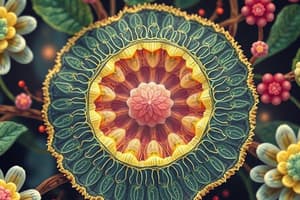Podcast
Questions and Answers
What is the primary function of the plant cell wall?
What is the primary function of the plant cell wall?
- Regulating nuclear transport
- Storage of genetic material
- Facilitating photosynthesis
- Providing structural and mechanical support (correct)
Which component is NOT typically found in the primary cell wall?
Which component is NOT typically found in the primary cell wall?
- Pectin
- Lignin (correct)
- Cellulose
- Hemicellulose
What role does the middle lamella play in plant cells?
What role does the middle lamella play in plant cells?
- It stores starch
- It is involved in cellular respiration
- It acts as a signal transducer
- It glues adjacent cells together (correct)
What is the function of the nucleolus within the nucleus?
What is the function of the nucleolus within the nucleus?
How do cellulose fibrils contribute to the cell wall structure?
How do cellulose fibrils contribute to the cell wall structure?
What characterizes the secondary cell wall in plant cells?
What characterizes the secondary cell wall in plant cells?
What is a common misconception regarding the cell wall's function?
What is a common misconception regarding the cell wall's function?
What happens to chromatin during cell division?
What happens to chromatin during cell division?
What is the primary function of ribosomes in a cell?
What is the primary function of ribosomes in a cell?
Which type of endoplasmic reticulum is involved in the production of proteins secreted outside the cell?
Which type of endoplasmic reticulum is involved in the production of proteins secreted outside the cell?
What do dictyosomes do after receiving vesicles?
What do dictyosomes do after receiving vesicles?
Which organelle is primarily involved in cell respiration and ATP production?
Which organelle is primarily involved in cell respiration and ATP production?
What is the main function of the central vacuole in plant cells?
What is the main function of the central vacuole in plant cells?
Which type of plastid is responsible for the green pigment in plants and photosynthesis?
Which type of plastid is responsible for the green pigment in plants and photosynthesis?
What role do peroxisomes play in plant cells?
What role do peroxisomes play in plant cells?
What happens to the central vacuole as plant cells grow?
What happens to the central vacuole as plant cells grow?
Flashcards are hidden until you start studying
Study Notes
Introduction to Plant Biology and Anatomy
- Plant cells are eukaryotic, meaning they have a nucleus and other membrane-bound organelles.
- Plant cells are differentiated from other eukaryotic cells by the presence of a rigid cell wall.
Cell Wall
- Provides structural support, maintaining and defining cell shape
- Resists internal pressure, controlling the rate and direction of growth
- Provides protection from physical injury
- Functions in carbohydrate storage and cell-cell interactions
- Composed of cellulose, pectin, hemicellulose, and lignin
- Primary cell wall is flexible and thin; secondary cell wall is thick and rigid
- Middle lamella glues adjacent cells together
Nucleus
- Contains genetic material (DNA) in the form of chromatin, which coils into chromosomes during cell division
- Surrounded by a nuclear envelope with pores that allow macromolecule movement
- Contains a nucleolus, which is responsible for ribosome production
Ribosomes
- Composed of rRNA and protein
- Responsible for protein synthesis
- Can be free in the cytoplasm or bound to the ER
Endoplasmic Reticulum
- Network of interconnected membranes that form a network throughout the cell's cytoplasm
- Rough ER is studded with ribosomes and is involved in protein synthesis for secretion
- Smooth ER is involved in lipid production
Dictyosomes (Golgi Apparatus)
- Flattened sacs of membrane called cisternae, involved in modifying and packaging proteins from the endoplasmic reticulum
- May also polymerize sugars into polysaccharides
Peroxisomes
- Membrane-bound sacs that detoxify byproducts of photosynthesis and are associated with chloroplasts
Mitochondria
- Powerhouses of the cell, responsible for cellular respiration, breaking down sugars and starches and producing ATP
Plastids
- Dynamic organelles with diverse functions
- Chloroplasts are green plastids responsible for photosynthesis
- Chromoplasts are colored plastids, and leucoplasts are translucent plastids
Central Vacuole
- Large, fluid-filled sac that stores water, salts, nutrients, and waste products
- Contributes to cell growth through turgor pressure
- Can store proteins, calcium, potassium, and pigments
Studying That Suits You
Use AI to generate personalized quizzes and flashcards to suit your learning preferences.




